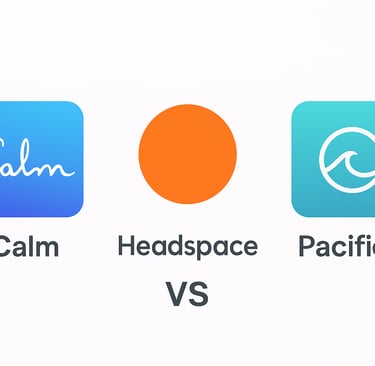Honest Review — Stress-Reduction Apps: Calm vs Headspace vs Pacifica (Sanvello)
STRESS MANAGEMENT
Team Alpha
11/2/20254 min read


Smartphones put evidence-based stress tools in your pocket. But how well do the biggest names — Calm, Headspace, and Pacifica (now Sanvello) — stand up to clinical science, expert reviews and real-world cost/value tradeoffs? Below I summarize the best available research, how long benefits appear, pricing, expert takeaways, and practical guidance so you can pick the right app for your goals.
Short summary (the bottom line)
All three apps show small-to-moderate benefits for stress, anxiety and depressive symptoms in trials — but the strength of evidence varies by app, study design and funding disclosure. PMC
Calm has randomized trial evidence for stress and sleep improvements in specific groups (e.g., college students), plus company-published clinical summaries. PubMed
Headspace has multiple trials showing reductions in stress and workplace outcomes; it’s often used in academic workplace studies and has independent evaluations. openresearch.surrey.ac.uk
Pacifica / Sanvello (Cognitive Behavioral Therapy [CBT] + mindfulness) has randomized evidence showing reductions in anxiety, depression and stress in users who engage with CBT tools. It tends to work well for users who actively use cognitive tools like thought records. jmir.org
Below: a deeper, referenced look so you can make an informed decision.
What the science says (clinical trials & reviews)
Meta-analytic context: A recent meta-analysis of app-delivered mindfulness interventions found small but significant improvements in anxiety and depression — meaning apps can help, but effects are typically modest and vary by engagement and study quality. This meta-analytic signal applies broadly to app-based mindfulness tools. PMC
Calm: A randomized, wait-list controlled trial of Calm among U.S. college students used an 8-week program and found reductions in perceived stress compared with waitlist controls; follow-ups suggested effects persisted short-term. Calm also publishes an online listing of clinical studies tied to its programs. These trials typically require daily practice (~10 minutes/day) for 4–8 weeks. PubMed
Headspace: Multiple RCTs of Headspace (including workplace and university samples) report reductions in perceived stress, improved work engagement and modest improvements in mood and attention. Headspace has been studied in occupational settings, with some employer-sponsored studies showing workplace benefits (lower stress, higher engagement). Headspace publishes research summaries and academic collaborators have run independent trials. openresearch.surrey.ac.uk
Pacifica / Sanvello: Pacifica’s RCTs (published in JMIR and related outlets) tested an integrated CBT + mindfulness app versus wait-list; results show reductions in self-reported anxiety, depression and stress — especially among users who used thought-record features and CBT modules regularly. Pacifica/Sanvello emphasizes CBT skills, mood tracking and problem-solving tools. jmir.org
Quality & conflicts of interest: A systematic review of Headspace and Calm trials pointed out conflicts of interest and variable risk-of-bias across studies (some trials are industry funded, and methodological quality varies). In short: promising results exist but scrutinize study design and funding disclosures. PMC
How quickly do benefits appear
Short term (days → 2 weeks): Some users report immediate subjective calm after a guided practice. A few controlled studies saw modest effects within 10–14 days for stress markers. Headspace
Medium term (4–8 weeks): The most robust trial effects (perceived stress, anxiety, sleep quality) generally emerge after consistent practice over 4–8 weeks — the typical window used by RCTs. PubMed
Long term (months): Maintenance depends on continued practice; many trials use short follow-ups, so long-term durability needs more real-world data.
Cost & access (current as published)
Calm: Free download with limited content; Calm Premium historically offered annual plans in the ballpark of ~£39/year or monthly subscriptions around £3.33/month (regional pricing varies). Calm also markets enterprise plans for employers. Healthline
Headspace: Free tier available; Headspace Premium commonly ~£49.99/year or monthly options (prices vary by promotion and org plans). Headspace is widely used in corporate wellbeing programs. Headspace
Pacifica / Sanvello: Pacifica was rebranded as Sanvello in many contexts; premium tiers are lower-cost than the big meditation apps — typical consumer pricing reported around £7.99/month or ~£47.99/year for premium features (and some employer/health-plan access is available). Pricing and branding vary by region and over time. Psychology Today
Note: app pricing changes frequently. Check each vendor’s pricing page for up-to-date offers and employer/health plan options.
Expert reviews & mainstream takeaways
Health journalists and consumer orgs generally praise Headspace and Calm for polished UX, high production values, and large libraries of guided content — making them easy for beginners. However, consumer reviews emphasize Headspace as slightly more structured (easier to build a daily habit) and Calm as stronger on sleep content (sleep stories, music). Expert reviewers note that both are best when used consistently. Healthline
Clinicians and digital-mental-health researchers praise Pacifica/Sanvello for integrating CBT tools (thought records, behavioral activation) that resemble therapist techniques — this can be powerful for mild-to-moderate anxiety/depression when users engage actively. However, its design and content are less meditation-focused and the UX is more utilitarian. jmir.org
Strengths & limitations — quick comparison
Calm
Strengths: Excellent sleep library, high production value, guided meditations for many use cases; RCTs in targeted populations. PubMed
Limitations: Price and occasional lack of transparency about trial funding have been flagged; engagement-driven outcomes vary.
Headspace
Strengths: Strong habit-building structure, multiple independent studies (including workplace), approachable micro-meditations and courses. Good for beginners and time-pressed pros. openresearch.surrey.ac.uk
Limitations: Effects modest unless used consistently; some trials have industry ties.
Pacifica / Sanvello
Strengths: CBT tools + mood tracking — good for people who want skills (not just meditation). RCT evidence supports symptom reduction when users engage with CBT features. jmir.org
Limitations: UX and content polish may lag behind Calm/Headspace; effectiveness depends heavily on user engagement with CBT modules.
Practical advice — who should pick which app?
You want better sleep & a soothing UX: Try Calm (sleep stories + meditations). Use 10–20 minutes nightly for 4–8 weeks and track sleep quality. Calm Health
You want structure & habit formation (work focus): Try Headspace — short daily practices, workplace programs and research backing in occupational samples. openresearch.surrey.ac.uk
You want skill acquisition for anxiety/depression (CBT tools): Try Pacifica/Sanvello — its CBT thought-record and mood-tracking features are evidence-based and suit people who want active skills. jmir.org
Final verdict
Mindfulness and CBT apps are useful low-cost tools that produce small-to-moderate benefits for stress, anxiety and sleep when used reliably. The best app is the one you’ll use consistently — but if you want research-backed starting points: Calm and Headspace have stronger brand RCT footprints (with caveats about funding and bias), while Pacifica/Sanvello is uniquely valuable if you want CBT-style coaching tools. Always treat apps as adjuncts, not replacements, for clinical care when symptoms are moderate-to-severe.
Insights
Expert guidance for health-conscious professionals.
Support
Connect
info@genthealthhub.com
© 2025. All rights reserved.
